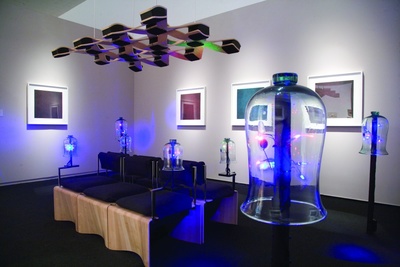GLASS HEART (BELLS FOR SYLVIA PLATH)
Davis Museum, Wellesley College • Wellesley, MA • davismuseum.wellesley.edu • Through June 9, 2013
Exhibition reopens September 3–December 15, 2013

Jenny Olivia Johnson’s Glass Heart (bells for Sylvia Plath)
installation at the Davis Museum. Photo: Steve Briggs.
Composer Jenny Olivia Johnson, whose music explores synesthesia and memory, presents her first museum commission, a site-specific interactive audiovisual installation in the Davis Museum’s Sight and Sound Gallery. As a synesthete herself (she involuntarily “sees” colors when she hears sounds and vice versa), Johnson lyrically connects the imagery of Sylvia Plath’s poetry and her perceptions of Sol LeWitt’s prints through her composition and installation. The gallery, with its sophisticated speaker system, is an ideal venue for the presentation of her work.
Johnson engaged with the 1991 LeWitt print suite, All Combinations of Red, Yellow, and Blue, with Scribbles, which the museum owns, at the suggestion of curator Elaine Mehalakes. The seven prints are composed of an allover scrim of delicately etched black lines against a solid, saturated aquatint background color, a different hue in each print. The prints hang in the gallery and necessitate a low lighting level for their conservation. The other source for the song and installation, and the source of its name, is Sylvia Plath’s poetry, and in particular the poem I Thought I Could Not Be Hurt, which depicts the human heart as an instrument made of glass.
The audience “plays” Johnson’s song via an “instrument” of seven glass bell jars wired with LED lights in a range of colors that blink in relation to the music. The jars, which are mounted on poles that are about four feet in height and spaced throughout the gallery, are responsive to a variety of stimuli including the velocity of the audience’s touch and each other. Each person hears different parts of the song, which is performed by a range of instruments including cello, synthesizer, and percussion as well as voice. The variety of stimuli and variability of responses means that the way the piece plays is not predictable.
As serious as this piece is, it is also a lot of fun to interact with. It adroitly addresses the subjectivity of experience through its form as it heightens awareness of the body in the space of the gallery. It is fortunate that it will be on display for an extended period, as one can return again and again with the assurance of a fresh experience each time.
—Mary Bucci McCoy
